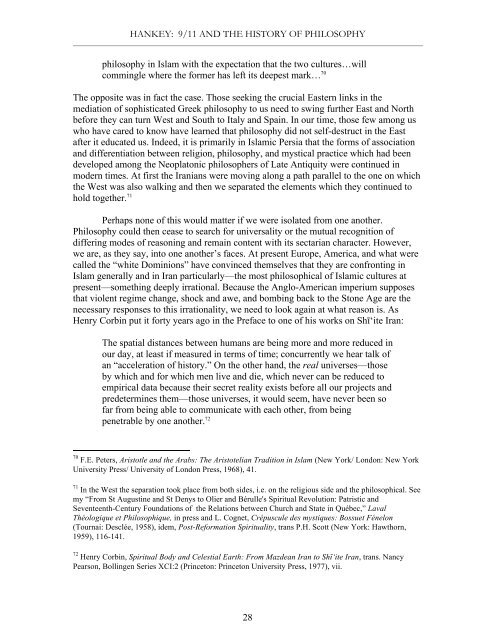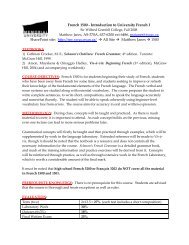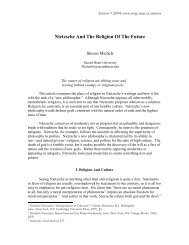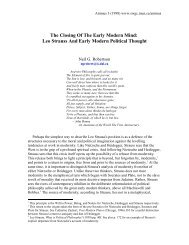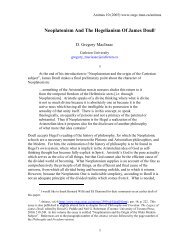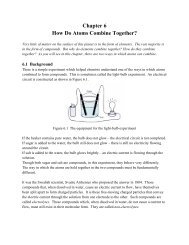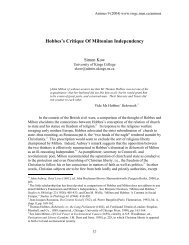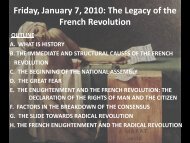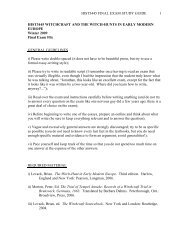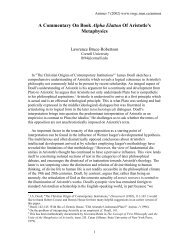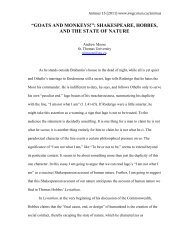Wayne Hankey, 9/11 and the History of Philosophy - Memorial ...
Wayne Hankey, 9/11 and the History of Philosophy - Memorial ...
Wayne Hankey, 9/11 and the History of Philosophy - Memorial ...
You also want an ePaper? Increase the reach of your titles
YUMPU automatically turns print PDFs into web optimized ePapers that Google loves.
HANKEY: 9/<strong>11</strong> AND THE HISTORY OF PHILOSOPHYphilosophy in Islam with <strong>the</strong> expectation that <strong>the</strong> two cultures…willcommingle where <strong>the</strong> former has left its deepest mark… 70The opposite was in fact <strong>the</strong> case. Those seeking <strong>the</strong> crucial Eastern links in <strong>the</strong>mediation <strong>of</strong> sophisticated Greek philosophy to us need to swing fur<strong>the</strong>r East <strong>and</strong> Northbefore <strong>the</strong>y can turn West <strong>and</strong> South to Italy <strong>and</strong> Spain. In our time, those few among uswho have cared to know have learned that philosophy did not self-destruct in <strong>the</strong> Eastafter it educated us. Indeed, it is primarily in Islamic Persia that <strong>the</strong> forms <strong>of</strong> association<strong>and</strong> differentiation between religion, philosophy, <strong>and</strong> mystical practice which had beendeveloped among <strong>the</strong> Neoplatonic philosophers <strong>of</strong> Late Antiquity were continued inmodern times. At first <strong>the</strong> Iranians were moving along a path parallel to <strong>the</strong> one on which<strong>the</strong> West was also walking <strong>and</strong> <strong>the</strong>n we separated <strong>the</strong> elements which <strong>the</strong>y continued tohold toge<strong>the</strong>r. 71Perhaps none <strong>of</strong> this would matter if we were isolated from one ano<strong>the</strong>r.<strong>Philosophy</strong> could <strong>the</strong>n cease to search for universality or <strong>the</strong> mutual recognition <strong>of</strong>differing modes <strong>of</strong> reasoning <strong>and</strong> remain content with its sectarian character. However,we are, as <strong>the</strong>y say, into one ano<strong>the</strong>r’s faces. At present Europe, America, <strong>and</strong> what werecalled <strong>the</strong> “white Dominions” have convinced <strong>the</strong>mselves that <strong>the</strong>y are confronting inIslam generally <strong>and</strong> in Iran particularly—<strong>the</strong> most philosophical <strong>of</strong> Islamic cultures atpresent—something deeply irrational. Because <strong>the</strong> Anglo-American imperium supposesthat violent regime change, shock <strong>and</strong> awe, <strong>and</strong> bombing back to <strong>the</strong> Stone Age are <strong>the</strong>necessary responses to this irrationality, we need to look again at what reason is. AsHenry Corbin put it forty years ago in <strong>the</strong> Preface to one <strong>of</strong> his works on Shī‘ite Iran:The spatial distances between humans are being more <strong>and</strong> more reduced inour day, at least if measured in terms <strong>of</strong> time; concurrently we hear talk <strong>of</strong>an “acceleration <strong>of</strong> history.” On <strong>the</strong> o<strong>the</strong>r h<strong>and</strong>, <strong>the</strong> real universes—thoseby which <strong>and</strong> for which men live <strong>and</strong> die, which never can be reduced toempirical data because <strong>the</strong>ir secret reality exists before all our projects <strong>and</strong>predetermines <strong>the</strong>m—those universes, it would seem, have never been s<strong>of</strong>ar from being able to communicate with each o<strong>the</strong>r, from beingpenetrable by one ano<strong>the</strong>r. 7270 F.E. Peters, Aristotle <strong>and</strong> <strong>the</strong> Arabs: The Aristotelian Tradition in Islam (New York/ London: New YorkUniversity Press/ University <strong>of</strong> London Press, 1968), 41.71 In <strong>the</strong> West <strong>the</strong> separation took place from both sides, i.e. on <strong>the</strong> religious side <strong>and</strong> <strong>the</strong> philosophical. Seemy “From St Augustine <strong>and</strong> St Denys to Olier <strong>and</strong> Bérulle's Spiritual Revolution: Patristic <strong>and</strong>Seventeenth-Century Foundations <strong>of</strong> <strong>the</strong> Relations between Church <strong>and</strong> State in Québec,” LavalThéologique et Philosophique, in press <strong>and</strong> L. Cognet, Crépuscule des mystiques: Bossuet Fénelon(Tournai: Desclée, 1958), idem, Post-Reformation Spirituality, trans P.H. Scott (New York: Hawthorn,1959), <strong>11</strong>6-141.72 Henry Corbin, Spiritual Body <strong>and</strong> Celestial Earth: From Mazdean Iran to Shī‘ite Iran, trans. NancyPearson, Bollingen Series XCI:2 (Princeton: Princeton University Press, 1977), vii.28


